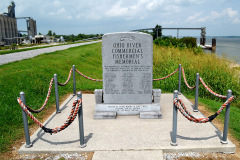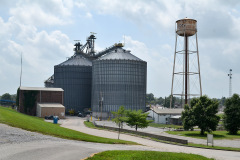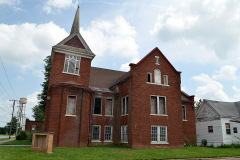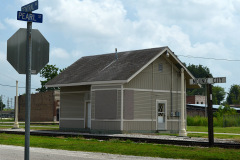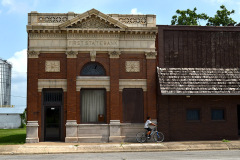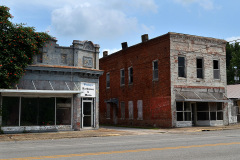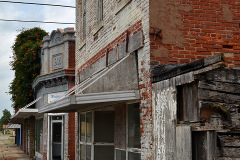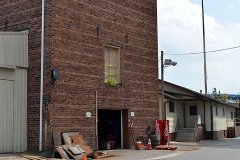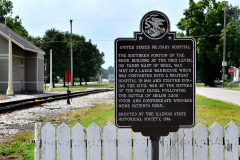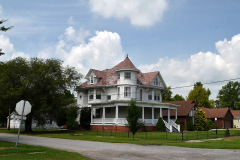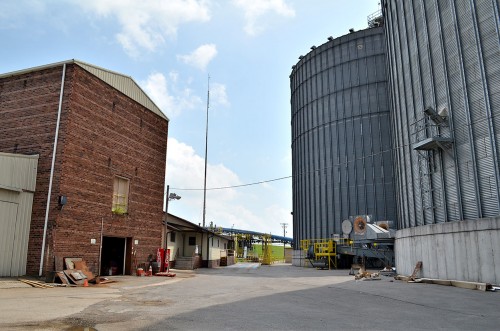 While researching the Saga of Sgt. Ginter, who is buried in the Mound City National Cemetery (as a sergeant, not as female camp follower in a Major’s uniform), I ran across some interesting tidbits of Civil War history about Mound City and Cairo, located about five miles apart on the Ohio River.
While researching the Saga of Sgt. Ginter, who is buried in the Mound City National Cemetery (as a sergeant, not as female camp follower in a Major’s uniform), I ran across some interesting tidbits of Civil War history about Mound City and Cairo, located about five miles apart on the Ohio River.
Mound City was the location of one of the largest Civil War hospitals in the western campaign. Even though no major battles were fought in the two cities, they received dead and wounded soldiers from Battles in Belmont, Commerce and Reed’s Point in Missouri; Fort Donelson and Shiloh in Tennessee; Fort Holt, Paducah and Columbus in Kentucky.
I was disappointed to learn that this brick building is all that’s left of what was described as one of the best administered of the military general hospitals.
Was also a naval depot
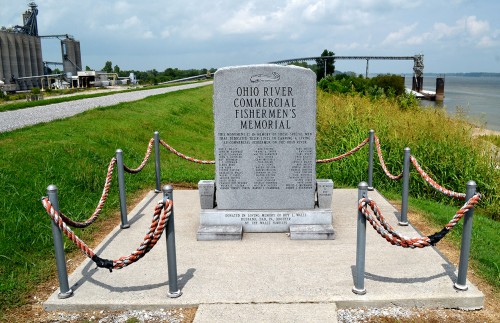 The National Register of Historic Places listing of Civil War Cemeteries contains the following information about Mound City. If you are interested in the cemetery part, here is a link to the full register.
The National Register of Historic Places listing of Civil War Cemeteries contains the following information about Mound City. If you are interested in the cemetery part, here is a link to the full register.
Mound City, Illinois, was founded at the abandoned settlement of Trinity in 1854. The city was located at the confluence of the Ohio and Cache Rivers. With the coming of the civil conflict, the riverfront became an extremely important Union naval facility for the Mississippi Squadron. A repair facility for the squadron was moved to Mound City due to the lack of space at Cairo.
Built three ironclads
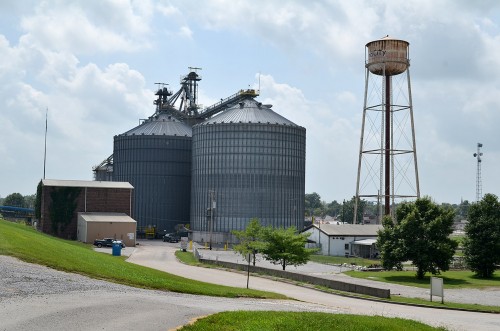 Throughout the Civil War, the Mound City naval depot was the only repair facility for the Mississippi Squadron, a fleet that numbered 80 ships. In addition to repairing and refitting vessels, the Mound City naval depot also shared in the construction of three ironclad gunboats. These were the U.S.S. Cairo, Cincinnati, and Mound City.
Throughout the Civil War, the Mound City naval depot was the only repair facility for the Mississippi Squadron, a fleet that numbered 80 ships. In addition to repairing and refitting vessels, the Mound City naval depot also shared in the construction of three ironclad gunboats. These were the U.S.S. Cairo, Cincinnati, and Mound City.
Heavy battles along the Tennessee, Cumberland, and Mississippi Rivers necessitated the establishment of hospital facilities to care for the wounded. Mound City was in a strategic location and the city’s hotel and foundry were converted into hospital facilities. High death rates from wounds and disease led to the establishment of the Mound City National Cemetery.
Red Rover hospital ship
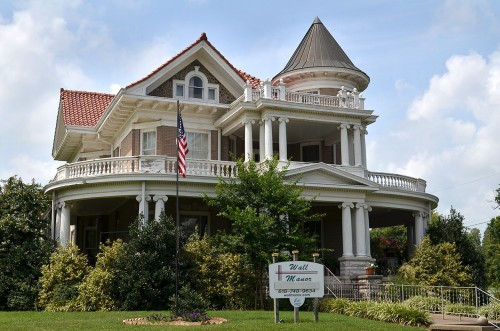 On April 7, 1862, the gunboat, Mound City, captured a side-wheel river steamer named the Red Rover which had been used by the Confederates as a floating barracks. The Red Rover was taken to St. Louis to be refitted as a floating hospital for the Western Flotilla. The ship was assigned to the U. S. Navy Hospital at Mound City.
On April 7, 1862, the gunboat, Mound City, captured a side-wheel river steamer named the Red Rover which had been used by the Confederates as a floating barracks. The Red Rover was taken to St. Louis to be refitted as a floating hospital for the Western Flotilla. The ship was assigned to the U. S. Navy Hospital at Mound City.
The Red Rover accompanied the flotilla through most engagements with the enemy, making many trips with wounded and dead to the Memphis and Mound City hospitals and cemeteries, treating the wounded along the bank of the Mississippi, scrounging for food and transporting medical supplies.
Important staging area
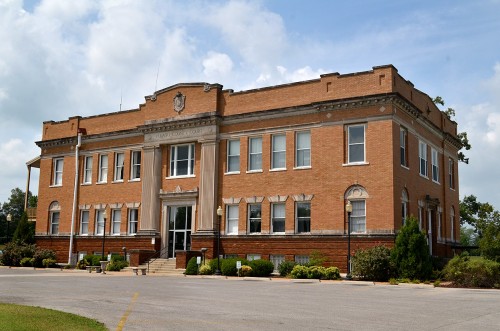 Although Mound City and nearby Cairo, Illinois, were not in the combat theater of the Civil War, their location near the confluence of the Ohio and Mississippi Rivers made these areas important staging points for the Tennessee and Cumberland Rivers for the Union forces. Three of the famous Eads ironclad gunboats were built at the Mound City marine ways and shipyard.
Although Mound City and nearby Cairo, Illinois, were not in the combat theater of the Civil War, their location near the confluence of the Ohio and Mississippi Rivers made these areas important staging points for the Tennessee and Cumberland Rivers for the Union forces. Three of the famous Eads ironclad gunboats were built at the Mound City marine ways and shipyard.
These specially designed shallow draft ironclads played an important part in the western campaign, giving valuable support to the Union troops on the Tennessee and Cumberland Rivers and at Vicksburg.
One of largest hospitals in the West
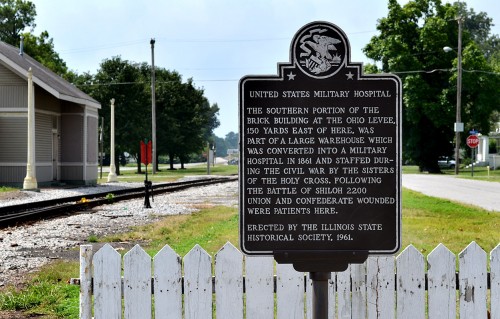 In 1861, a large brick building in Mound City was taken over by the United States Government for use as a general hospital. In service throughout the war, it was one of the largest military hospitals in the west. Another large hospital was established at Cairo.
In 1861, a large brick building in Mound City was taken over by the United States Government for use as a general hospital. In service throughout the war, it was one of the largest military hospitals in the west. Another large hospital was established at Cairo.
Roman Catholic nuns of the Order of the Holy Cross at Notre Dame, South Bend, Indiana, were utilized as nurses to staff these hospitals. The establishment of these large hospitals at Mound City and Cairo was a determining factor in the location of the Mound City National Cemetery.
The hospital at Mound City was able to accommodate from 1,000-1,500 patients and has been described as one of the best administered of the military general hospitals.
First patients came from Battle of Belmont
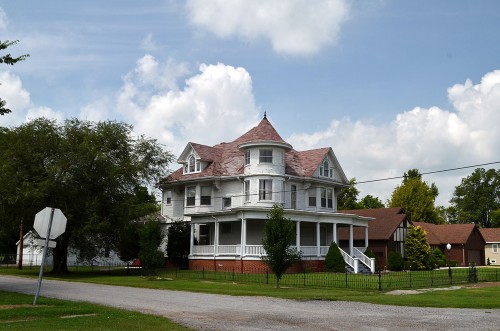 The first patients at the Mound City General Hospital were the wounded from the Battle of Belmont, Missouri, November 7, 1861. Heavy fighting at Fort Donelson, February 13-16, 1862, and at Shiloh April 6-7, 1862, brought many more patients to the Mound City and Cairo hospitals.
The first patients at the Mound City General Hospital were the wounded from the Battle of Belmont, Missouri, November 7, 1861. Heavy fighting at Fort Donelson, February 13-16, 1862, and at Shiloh April 6-7, 1862, brought many more patients to the Mound City and Cairo hospitals.
The death rate from wounds and all prevalent diseases was high in the hospitals of the Civil War period.
Other bodies were removed from Cairo and its vicinity in Pulaski County; in Missouri from Belmont in Mississippi County; Reed’s Point and Commerce in Scott County; in Kentucky from Fort Holt in Bailon County, Columbus in Hickman County, and Paducah in McCracken County.
There are 2,759 unknown soldiers buried in the Mound City National Cemetery, as well as 27 Confederate soldiers who died in the wartime hospitals of the area.
Photo gallery of Mound City
Mound City, like Cairo, has seen better days. I was fascinated by a 1905 hardware store on Main Street. I was even more fascinated when I saw the roof had fallen in and the inside was returning to nature. Click on any photo to make it larger, then use your arrow keys to move through the images.



